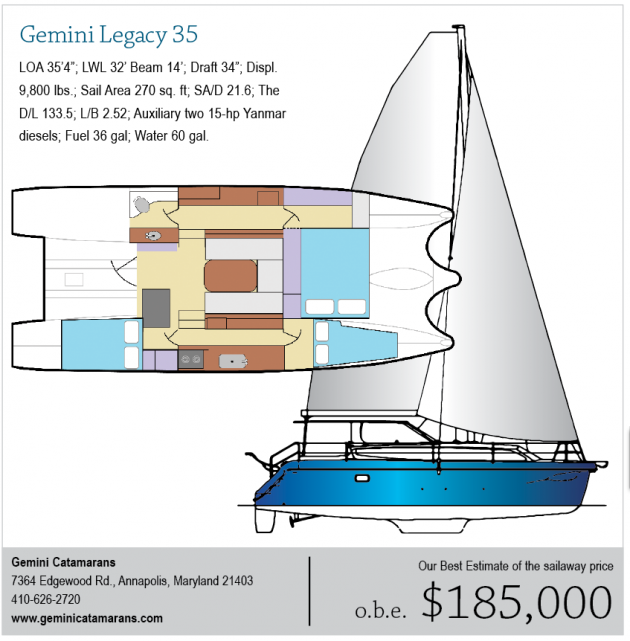Gemini Legacy 35
Cruising catamaran
 With the America's Cup in San Francisco this summer, there is a lot of interest in catamarans. Certainly, from what I see, the big AC cats are spectacular and powerful machines, and made even more spectacular by the fact that they are riding on foils.
With the America's Cup in San Francisco this summer, there is a lot of interest in catamarans. Certainly, from what I see, the big AC cats are spectacular and powerful machines, and made even more spectacular by the fact that they are riding on foils.
This is quite a change from the lumbering 12-Meters of the past that, as a boy, I thought were the ultimate speed machines. I got to crew on a 12-Meter once. I'm not sure they'd even let me near one of the new AC cats. Whether it is a wave-piercing, foil-borne racing cat or a chunky cruising cat, cats are now mainstream and the choice for a lot of sailors.
The new catamaran from the Gemini factory in Maryland is the cruising cat variety with the design emphasis on comfort and accommodations. The D/L of this design is 133.5, and the L/B is 2.52. The displacement is listed at 9,800 pounds, and that's not light even for a monohull 35-footer. If you consider that the Gemini has no ballast you can get an appreciation of just how much material there is in this boat.
There is minimal rocker to the hulls, and the tip of the transoms are immersed at rest. The draft is only 34 inches with very low-aspect-ratio fixed fins. There is 39 inches of bridgedeck clearance at the bow, but I'm not sure what it is amidships. It appears to be around 24 inches by my eye. There is a podlike structure on centerline forward that I think is there to break up wave impact on the bridgedeck.
Like most cruising cats, the Gemini 35's wheel is mounted off to one side of the cockpit. If it were on centerline, as you would usually find it in a monohull, you would have a difficult time seeing around the cabintrunk. This wheel is bulkhead mounted to starboard with the option of a comfortable powerboat-style helm chair.
All sheets and sail controls are led aft to the helm position. Other cockpit options include a "hammock" across the center portion of the stern or a fixed centerline bench seat with a small table for dining. From the level of the main cockpit you step down to a very broad swim platform.
A full, hard bimini offers protection from sun or rain. This cat has no trampolines connecting the two hulls; it is all GRP deck. My only concern is the outboard location of the jib leads. For close beating I'd like to see an angle closer to 10 degrees maximum.
When you consider this cat has an LOA of 35 feet 4 inches, the layout is impressive. There are three staterooms with double berths. The double forward in the starboard hull looks a bit tight, but it will work. The galley stretches down the middle section of the starboard hull, and you can pass through from the galley to the dining area. I think seating six people around that dining table might be a challenge, but with those big windows all around the feeling will be spacious. There is one head aft on the port side.
The sailplan shows a boxy-looking boat. The photos of the finished boat sailing show something very different. This is a very good looking 35-foot cat. The sweeping contours of the deck structures play well with the beam. With the square-topped mainsail and what looks to be a 120% LP jib, the SA/D is 21.6. The mainsheet goes to a traveler on top of the bimini support aft, then leads forward and back aft to the winch by the helm position. Chainplates are outboard on the hulls. An asymmetrical chute tacks to the long anchor-roller unit.
I've never gone cruising on a big cat. I've sailed them though. Cats offer some truly distinct design features that you don't find on monohulls. Apparently these features are being well received.

Comments